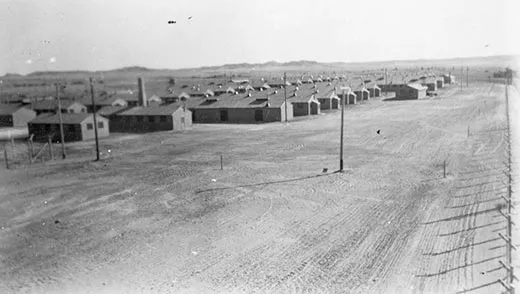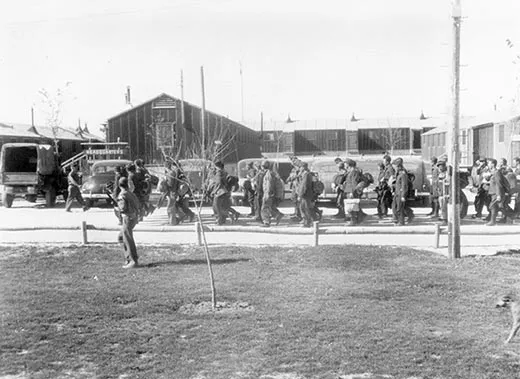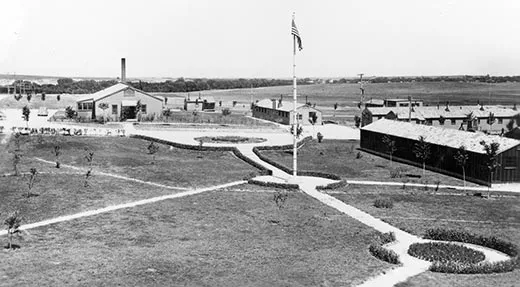German POWs on the American Homefront
Thousands of World War II prisoners ended up in mills, farm fields and even dining rooms across the United States
/https://tf-cmsv2-smithsonianmag-media.s3.amazonaws.com/filer/German-POW-marching-631.jpg)
In the mid-1940s when Mel Luetchens was a boy on his family’s Murdock, Nebraska, farm where he still lives, he sometimes hung out with his father’s hired hands, “I looked forward to it,” he said. “They played games with us and brought us candy and gum.” The hearty young men who helped his father pick corn or put up hay or build livestock fences were German prisoners of war from a nearby camp. “They were the enemy, of course,” says Luetchens, now 70 and a retired Methodist minister. “But at that age, you don’t know enough to be afraid.”
Since President Obama’s vow to close the Guantanamo Bay Detention Camp erupted into an entrenched debate about where to relocate the prisoners captured in the Afghanistan War, Luetchens has reflected on the “irony and parallel” of World War II POWs and Guantanamo inmates. Recently, the Senate overwhelmingly rejected providing funds to close the U.S. military prison in Cuba, saying that no community in America would want terrorism suspects in its backyard.
But in America’s backyards and farm fields and even dining rooms is where many enemy prisoners landed nearly 70 years ago. As World War II raged, Allies, such as Great Britain, were running short of prison space to house POWs. From 1942 through 1945, more than 400,000 Axis prisoners were shipped to the United States and detained in camps in rural areas across the country. Some 500 POW facilities were built, mainly in the South and Southwest but also in the Great Plains and Midwest.
At the same time that the prison camps were filling up, farms and factories across America were struggling with acute labor shortages. The United States faced a dilemma. According to Geneva Convention protocols, POWs could be forced to work only if they were paid, but authorities were afraid of mass escapes that would endanger the American people. Eventually, they relented and put tens of thousands of enemy prisoners to work, assigning them to canneries and mills, to farms to harvest wheat or pick asparagus, and just about any other place they were needed and could work with minimum security.
About 12,000 POWs were held in camps in Nebraska. “They worked across the road from us, about 10 or 11 in 1943,” recalled Kelly Holthus, 76, of York, Nebraska. “They stacked hay. Worked in the sugar beet fields. Did any chores. There was such a shortage of labor.”
“A lot of them were stone masons,” said Keith Buss, 78, who lives in Kansas and remembers four POWs arriving at his family’s farm in 1943. “They built us a concrete garage. No level, just nail and string to line the building up. It’s still up today.”
Don Kerr, 86, delivered milk to a Kansas camp. “I talked to several of them,” he said. “I thought they were very nice.”
“At first there was a certain amount of apprehension,” said Tom Buecker, the curator of the Fort Robinson Museum, a branch of the Nebraska Historical Society. “People thought of the POWs as Nazis. But half of the prisoners had no inclination to sympathize with the Nazi Party.” Fewer than 10 percent were hard-core ideologues, he added.
Any such anxiety was short-lived at his house, if it existed at all, said Luetchens. His family was of German ancestry and his father spoke fluent German. “Having a chance to be shoulder-to-shoulder with [the prisoners], you got to know them,” Luetchens said. “They were people like us.”
“I had the impression the prisoners were happy to be out of the war,” Holthus said, and Kerr recalled that one prisoner “told me he liked it here because no one was shooting at him.”
Life in the camps was a vast improvement for many of the POWs who had grown up in “cold water flats” in Germany, according to former Fort Robinson, Nebraska, POW Hans Waecker, 88, who returned to the United States after the war and is now a retired physician in Georgetown, Maine. “Our treatment was excellent. Many POWs complained about being POWs—no girlfriends, no contact with family. But the food was excellent and clothing adequate.” Such diversions as sports, theater, chess games and books made life behind barbed wire a sort of “golden cage,” one prisoner remarked.
Farmers who contracted for POW workers usually provided meals for them and paid the U.S. government 45 cents an hour per laborer, which helped offset the millions of dollars needed to care for the prisoners. Even though a POW netted only 80 cents a day for himself, it provided him with pocket money to spend in the canteen. Officers were not required to work under the Geneva Convention accords, which also prohibited POWs from working in dangerous conditions or in tasks directly related to the war effort.
“There were a few cases when prisoners told other prisoners not to work so hard,” said historian Lowell May, author of Camp Concordia: German POWs in the Midwest. Punishment for such work slowdowns was usually several days of confinement with rations of only bread and water.
“One prisoner at Camp Concordia said a good German would not help the Americans,” May said. “He was sent to a camp for Nazi supporters in Alva, Oklahoma.”
Of the tens of thousands of POWs in the United States during World War II, only 2,222, less than 1 percent, tried to escape, and most were quickly rounded up. By 1946, all prisoners had been returned to their home countries.
The deprivations of the postwar years in Europe were difficult for the repatriated men. The Luetchens, who established a “lively” letter exchange with their POW farmhands, sent them food and clothing. Eventually Luetchen and his parents visited some of them in Germany.
Recently Luetchens considered those experiences in the context of current controversies about Guantanamo detainees. “It was less scary then,” he concluded, but he expressed hope for understanding others, even your designated enemies.
“When you know people as human beings up close and understand about their lives, it really alters your view of people and the view of your own world.”


